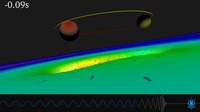
Photo from wikipedia
The application of a recent field theory of deformation and fracture to nondestructive testing (NDT) is discussed. Based on the principle known as the symmetry of physical laws, the present… Click to show full abstract
The application of a recent field theory of deformation and fracture to nondestructive testing (NDT) is discussed. Based on the principle known as the symmetry of physical laws, the present field theory formulates all stages of deformation including the fracturing stage on the same theoretical basis. The formalism derives wave equations that govern the spatiotemporal characteristics of the differential displacement field of solids under deformation. The evolution from the elastic to the plastic stage of deformation is characterized by a transition from longitudinal (compression) wave to decaying longitudinal/transverse wave characteristics. The evolution from the plastic to the fracturing stage is characterized by transition from continuous wave to solitary wave characteristics. Further, the evolution from the pre-fracturing to the final fracturing stage is characterized by transition from the traveling solitary wave to stationary solitary wave characteristics. In accordance with these transitions, the criterion for deformation stage is defined as specific spatiotemporal characteristics of the differential displacement field. The optical interferometric technique, known as Electronic Speckle-Pattern Interferometry (ESPI), is discussed as an experimental tool to visualize those wave characteristics and the associated deformation-stage criteria. The wave equations are numerically solved for the elastoplastic stages, and the resultant spatiotemporal behavior of the differential displacement field is compared with the experimental results obtained by ESPI. Agreement between the experimental and numerical results validates the present methodology at least for the elastoplastic stages. The solitary wave characteristics in the fracturing stages is discussed based on the experimental results and dislocation theory.
Journal Title: Applied Sciences
Year Published: 2020
Link to full text (if available)
Share on Social Media: Sign Up to like & get
recommendations!